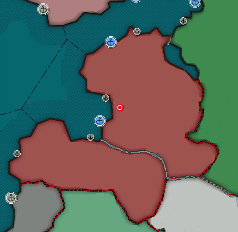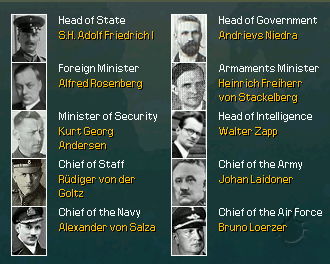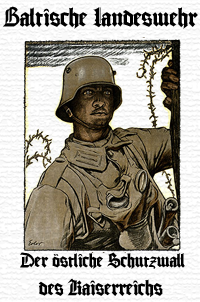United Baltic Duchy
From Kaiserreich
| ||||

| ||||
| Official Language | German | |||
| Capital | Riga | |||
| Head of State | Adolf Friedrich | |||
| Head of Government | Andrievs Niedra | |||
| Establishment - Treaty of Brest-Litovsk | March 3, 1918 | |||
| Government | Constitutional Monarchy | |||
| Currency | Papiermark | |||
| Area | 109 817 km² | |||
| Population | About 4.5 millions | |||
The United Baltic Duchy is a country is North Europe. It borders Russia to the east, White Ruthenia to the southeast, Lithuania to the south and Germany to the southwest.
Contents |
History
The United Baltic Duchy was established as a tributary state of the German Empire in the aftermath of the collapse of the Russian Empire in the face of decisive German offensives. The early days of the Duchy were not the best ones, as it had to fight for survival in the face of nationalist Estonian and Latvian forces, supported by the Entente. The bolshevik threat from the east, the general chaos in the years of the Russian Civil War until German intervention helped ensure White Russian victory, all this has left a mark on the baltic country.
The Baltische Landeswehr, the armed forces of the newly established state, performed admirably during the wars of establishment and even came to be semi-seriously referred to as the östliche Schutzwall des Kaiserreichs (the Eastern Rampart of the Empire). The term was quickly picked up by official Duchy propaganda agencies to stress the importance of the Baltic state to the Empire as a whole.
Initially, and unlike other states established in the areas of western Russia ceded to Germany, the United Baltic Duchy was expected to one day become a formal constituent state of the German Empire. However, internal problems in both the Fatherland and in the Duchy itself have delayed initial plans.
Politics
|
Duke: His Highness Adolf Friedrich (born 10 October 1873)
Prime Minister: Andrievs Niedra (born 8 February 1871)
Minister of Relations with the German Empire: Alfred Rosenberg (born 12 January 1893)
Minister of Economy: Baron Heinrich von Stackelberg (born 31 October 1905)
Minister for Colonization: Hans Georg Andersen
Director of Secret Services: Walter Zapp (born 4 September 1905)
Chief of the General Staff of the Baltische Landeswehr: General Rüdiger von der Goltz (born in 1865)
Commander of the Baltische Landeswehr: General Johan Laidoner (born 12 February 1884)
Commander-in-Chief of the Baltische Marine: Admiral Alexander von Salza (born 16 April 1885)
Commander-in-Chief of the Baltische Luftwaffe: Bruno Loerzer (born 22 January 1891)
Administratively, the Duchy is subdivided into two Stadte, Riga and Revel, and four Lander, which are Oselland, Estland, Livland and Kurland. As the country is organised along unitarian lines, the regions have only very little power. Moreover, recent tensions with rural Estonian and Latvian populations has prompted the formation of two specialised security commands for Livland and Estland.
In fact, the lack of strong authority over the Lander of Estland, Livland and Kurland severely hampers the economy. As economic stagnation and recession nears, old feuds between largely urban Germans and rural non-Germans gain new strength. Some propose encouraging Germans to settle the land, others wish to integrate the local population fully into the political life. In the end, the choice is in between finally integrating into the Empire or emancipating from the Imperial authority.
Military
|
The Baltiche Landeswehr is military the United Baltic Duchy, formed in the aftermath of its creation in 1918 as a first line of defence against nationalist latvian and estonian insurgents, as well as bolshevik and even Entente expeditions. The Landeswehr comprises several ground divisions, as well as a small air arm and a naval arm. Service is voluntary and open to Ducal citizens of German origins and background.
The headquarters of the Landeswehr are established in Riga, the Duchy's capital. Riga is also home to the Iron Division(cavalry), the strongest and most capable of all Landeswehr divisions. The remaining forces are divided into two "corps". The Northern Corps has its headquarters at Narva and is comprised of the 1st German-Baltic Division (infantry) and of the Estland Security brigade. The Eastern Corps has its headquarters at Dagauvpils and comprises the 2nd German-Baltic Division (infantry) and the Livland Security brigade.
The Landeswehr's air arm comprises a single squadron of interceptors. The naval arm comprises a single Heavy Cruiser, the VBHS Feuchtwangen, and a small detachment of screening and support ships.
All in all, the Baltiche Landeswehr is a small force, equipped and trained in accordance with German parameters and closely integrated with the German army. It's small size makes it oriented largely on upkeeping interior peace than providing any realistic resistance in case of a Russian invasion.
Foreign relations
The United Baltic Duchy is under the political, economical and military authority of Germany and grants military access to German units. It is a member of Mitteleuropa and is considered the "Vanguard in the east" of the German Empire.
Very good relations with Germany, Lithuania and White Ruthenia.
Friendly relations with Austria and Poland.
Unfriendly relations with Russia.
Culture
In this rather small client state of the German Empire, the full spectrum of political powers is concentrated with the Baltic German minority, who live mainly in the cities of Riga, Revel and the islands of Osel and Dago. The rest of the country is populated mainly by rural Estonian and Latvian populations.




